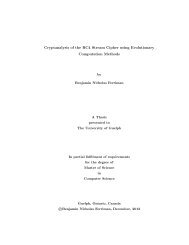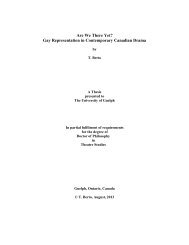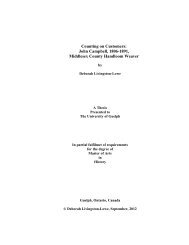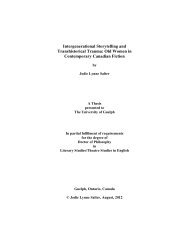THESIS - ROC CH ... - FINAL - resubmission.pdf - University of Guelph
THESIS - ROC CH ... - FINAL - resubmission.pdf - University of Guelph
THESIS - ROC CH ... - FINAL - resubmission.pdf - University of Guelph
Create successful ePaper yourself
Turn your PDF publications into a flip-book with our unique Google optimized e-Paper software.
8.0 CONCLUSIONS AND RECOMMENDATIONS<br />
Increasing interest into biodegradable alternatives for petroleum plastics has<br />
perpetuated current research for environmentally sustainable protein-based plastics. Each part<br />
<strong>of</strong> this study contributed to this ideal by exploring the processing and properties <strong>of</strong> extruding a<br />
protein composite film derived solely from the soy plant.<br />
The first part <strong>of</strong> this study showed that under optimized conditions, SPI can be extruded<br />
directly into thin, smooth-surfaced films. The processing window for this is however very limited<br />
and highly sensitive to both moisture content and heat applied. The presence <strong>of</strong> water forms<br />
microscopic holes in the thin films and is thought to nucleate the formation <strong>of</strong> macroscopic<br />
bubbles seen during extrusion. The continuous extrusion <strong>of</strong> puffed films with sustained bubbles<br />
was readily achievable through the use <strong>of</strong> high moisture and high heat. Mechanical properties <strong>of</strong><br />
the extruded thin films were highly sensitive to relative humidity. But at RH <strong>of</strong> 58% or lower, SPI<br />
films exhibited comparable mechanical properties to synthetic polymers. Barrier characteristics<br />
were strong against oxygen but poor against water as expected. Furthermore, FTIR analysis<br />
revealed that the extrusion process facilitated the transformation <strong>of</strong> SPI from mixed β strands to<br />
parallel β-sheet structures. The realization <strong>of</strong> extruding continuous homogenous SPI thin films<br />
facilitates industrial integration increasing commercial potential for sustainable bioplastics.<br />
The second part affirms that nano to micro cellulose fibers can be extracted from unused<br />
stems and pods <strong>of</strong> the soy plant. The chemi-mechanical process employed yielded two fractions<br />
<strong>of</strong> fibers with differing size distribution, chemical composition, and crystallinity. Confirmed by<br />
TEM, a nano-sized fraction was obtained after acid hydrolysis. WAXD showed that crystalline<br />
characteristics were present but the presence <strong>of</strong> pectin and hemicellulose was strong as<br />
witnessed by FTIR. The bulk fraction obtained after both chemical and mechanical treatment<br />
had a size distribution ranging from nano to micron sizes. FTIR and SEM analysis <strong>of</strong> each<br />
107

















